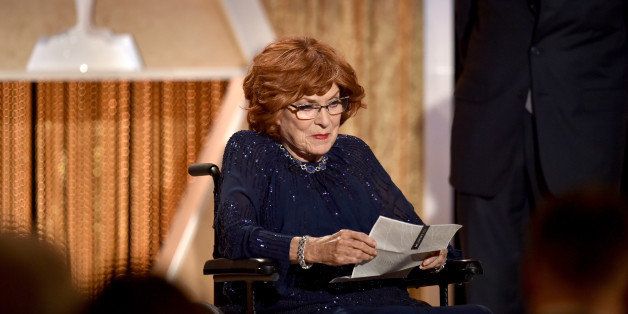
"This is what it's all about." -- Harvey Weinstein to Benedict Cumberbatch and director Morten Tyldum on leaving the Governors Awards, November 9, 2014
* * *
The midnight blue of the bracing Idaho sky was the color of her beaded gown, reflecting the sparkle in her green eyes. The legendary red hair was perfectly coiffed; the tasteful diamond bracelets added a touch of glamour. The high-powered audience, gathered in the heart of Hollywood at the beginning of awards season, suddenly quieted as the evening began with a film tribute honoring the ravishingly beautiful actress who never gave less than a perfect performance in her seven-decade career.
Martin Scorsese defined her impact: "She started at the very top, at age 18, starring with and working with the best and most brilliant-- only to remain there."
After Liam Neeson reflected on his infatuation in seeing THE QUIET MAN, and Clint Eastwood, as a Universal contract player, told of his attempts to get close to LADY GODIVA, the audience rose in awe and appreciation as Maureen O'Hara appeared to receive the Oscar that had long eluded her.
In this case, the standing ovation was more than obligatory. It was heartfelt and exciting. We were in the presence of a breed of movie star whose persona was so individual, so distinctive and so appealing that her name alone brought a passion and a reason for going to the movies.
Now, she was back in Idaho, in her home outside Boise, with her golden statuette, close to her grandson, Conor Fitzsimons and his loving family.
When I first learned Maureen O'Hara had moved to Idaho, thirty minutes from where I lived, I thought it impossible. That she would settle in the high desert, so different from the Caribbean, where she had once retired to run an airline with her late husband, General Charles Blair, or to her beloved Ireland, for which she was its most renowned citizen. It seemed incongruous.
As a teen growing up in Providence, R.I., I had two understandings with my parents about when I could watch television beyond my strict 10:00 PM bedtime. The first dispensation was for the annual Academy Awards show. The second was that I'd be in bed when THIS IS YOUR LIFE aired..."Unless it was Maureen O'Hara." On March 27, 1957, Maureen O'Hara became the show's surprised subject as she was being interviewed on the red carpet about THE WINGS OF EAGLES, prior to the Oscar telecast. That night became a double treat.
Thirty years later, living in Los Angeles, I flew to New York for a special showing of THE QUIET MAN, which she introduced at The Film Society of Lincoln Center. I hoped to meet her and see if she'd be interested in playing a key role in a film of CASHEL BYRON'S PROFESSION, based on the novel by George Bernard Shaw. She responded to the idea of a Shaw project, with provisions of script approval. I was nearly tongue-tied being next to my formidable teen crush.
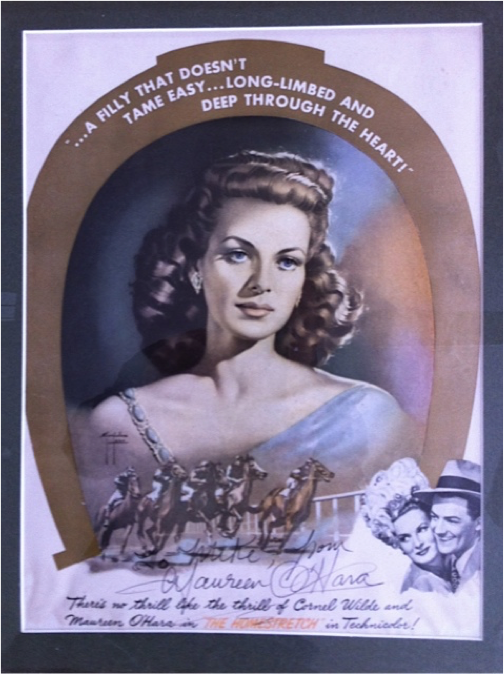
I had brought along a favorite image -- a painting by Sergio Garguilo used for the lavish trade ad for HOMESTRETCH, a romantic horseracing drama with Cornel Wilde from her peak 20th Century Fox period.
Garguilo created more film campaigns in more countries than any other artist and in his airbrush rendering of O'Hara, she never looked more enticing, framed within a gold horseshoe. She autographed the piece, which she had never seen, and which I subsequently framed.
It was prominently displayed in our living room when it caught the eye of a visiting friend who nonchalantly reported, "I just read she's moved to Boise.''
I was flabbergasted; I was in the midst of advocating for Maureen O'Hara to receive an Honorary Oscar.
* * *
Like any worthwhile recognition, -- an award, a cause, a political position -- nothing happens in a vacuum. Everything requires work and imagination, a combination of creativity and that dreaded word, lobbying.
My first award attempt began in 1982, incensed that Lillian Gish had yet to be recognized with the American Film Institute's Life Achievement Award. The criteria for that honor states, "the recipient should be one whose talent has in a fundamental way advanced the film art; whose accomplishment has been acknowledged by scholars, critics, professional peers and the general public; and whose work has stood the test of time."
Lillian was knowledgeable about every aspect of filmmaking, having leaned the craft from D.W. Griffith, who discovered her and made her the leading lady of his most famous and successful films (WAY DOWN EAST, ORPHANS OF THE STORM, THE BIRTH OF A NATION). She was a major star of deep artistic integrity, with a "wild imagination" as Andrew Sarris once wrote. After a screening of A CLOCKWORK ORANGE, she equated it to "a modern SATYRICON".
In 1925, she signed an exclusive contract with MGM which gave her creative control in choosing story, cast and director. For her deathbed scene in LA BOHEME, she prepared by observing tubercular patients, not drinking for three days and placing cotton in her cheeks to convey her fatal illness. Director King Vidor thought she had actually died when filming it.
Gish combined curiosity with commitment. Her mantra, which she stated on important occasions: "What you get is a living. What you give is a life."
It was hypocritical and outrageous that there should be any question that Gish should receive that recognition. Orson Welles, after being the third recipient, told Johnny Carson on THE TONIGHT SHOW that Lillian Gish was the person most worthy of being so honored, not him. Not only had she created the art of film acting but she was the tireless spokesperson and catalyst for film preservation.
Nevertheless I was being discouraged. Allied AFI board members felt the full board would never agree. Lillian Gish was most famous for her silent film work, great as it was, but silents weren't a ratings draw for CBS.
Setting aside two months to campaign in the third year of my compulsion, more important film names were approached to write letters for "the first lady of film", and in a final effort, I discussed the oversight with Charles Champlin, the influential film critic and arts editor of the Los Angeles Times.
Chuck's column appeared the morning the decision was to be made. Once I read it, I felt it was a lost cause. While Chuck persuasively listed the many reasons Miss Gish should be chosen, he wrote that a noble campaign was being waged by me, naming me.
This was a red flag; acknowledging "a campaign" could alienate board members. I worked behind the scenes and believed in silent strategy.
I worried needlessly.
Times were changing; the details of "marketing" would soon be fodder for the mainstream press and staged "media events" would be openly announced.
In 1984, Lillian Gish became the American Film Institute's 12th Life Achievement Award recipient.
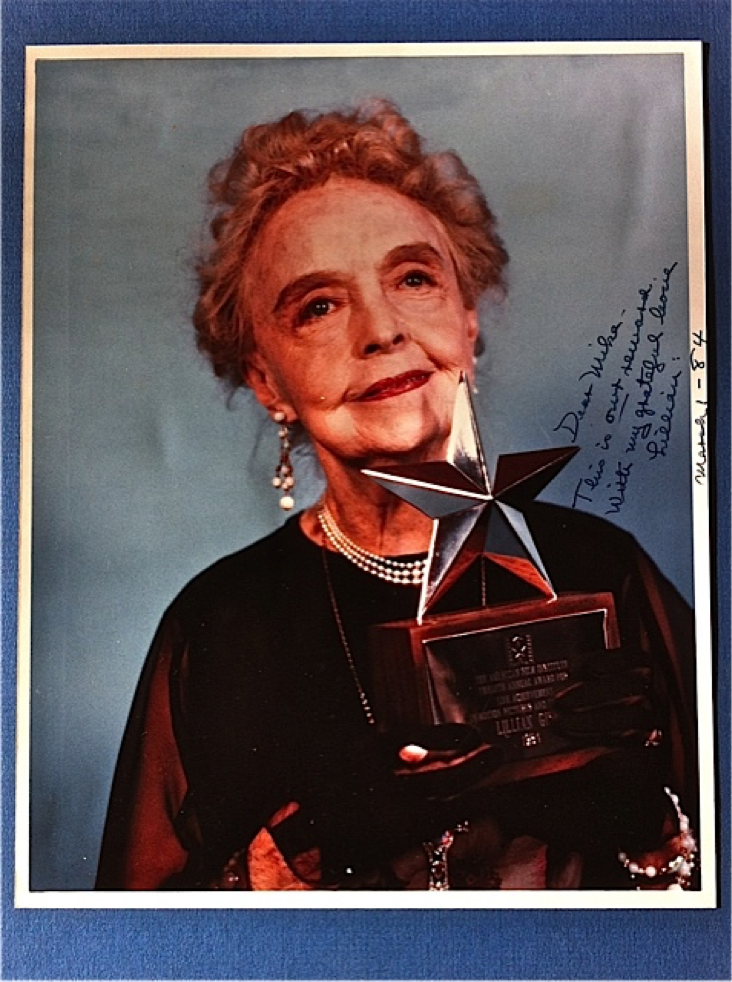
***
The Honorary Academy Award is a special honor I've always felt should be presented to film artists who had been overlooked by the vagaries of the competitive awards. The annual Oscars are an honor bestowed by fellow peers but it isn't an immaculate process. Over the years, results could depend on many factors: studio affiliation, rule changes, personal popularity, membership exposure, campaign budgets.
The Honorary Oscar is given in recognition of a body of work, not a single credit. Greta Garbo, Cary Grant, Alfred Hitchcock, Fred Astaire, Howard Hawks and Barbara Stanwyck are among the movie giants who never won a competitive race but received Honorary Oscar acknowledgement.
Jean Harlow, Jean Arthur, William Powell, Irene Dunne, Carole Lombard, Ann Sothern, Raoul Walsh, Vincent Price, Joel McCrea, Otto Preminger, James Mason, Montgomery Clift and Marlene Dietrich reached celluloid heaven Oscar-less.
Like Myrna Loy and Edward G. Robinson, Maureen O'Hara could be among the few defining Golden Age actors to receive an Honorary Oscar without having been previously nominated.
* * *
By 2005, Robert Altman had been nominated 5 times for directing films that had reinvented nearly every movie genre. His previous ensemble piece, 2001's GOSFORD PARK, revitalized the classic British mansion whodunit, was a popular success and received seven nominations, his included. It seemed as though he would finally reach the podium but it was a near miss. His newest, PRAIRIE HOME COMPANION, would be released later that year, but was more challenging than GOSFORD and less likely to get Academy attention.
He was also 80 years old and being a friend and colleague for thirty years, I was concerned about his health. The previous year, I began marshalling support but began too late. Paul Newman advised there was already a substantial movement for Sidney Lumet. So I vowed to get a head start in spearheading his recognition for the 2005 awards, assisted by PR maven Lois Smith and New York agent Boaty Boatright. There was no question that Altman, who had not only influenced but changed how films could be made, was a choice the Governors had to acknowledge.
Bob knew I wanted this to happen but we never talked about it. We just went about our business. During the next three months, everything seemed to fall into place.
Then a well-intentioned spoiler materialized, who questioned whether Bob would accept the award. He was afraid that like Peter O'Toole, who wanted to win a competitive Oscar, Altman would feel the Honorary Award would be a consolation prize as he was still active and very competitive.
Lois Smith woke me with the news that Bob had been asked by an intermediary and declined. He was directing an Arthur Miller play, RESURRECTION BLUES, in London and couldn't be in Los Angeles for the ceremony. And added he could get the award at another, more convenient time.
I couldn't believe anyone, knowing anything about Bob, would pose that question, forcing his hand, "Do you want the Honorary Oscar?" I was in a state of shock; Lois, a counselor of calm, moved on, "What can we do?"
Kathryn Altman, Bob's sharp and all-knowing wife, gave me the lay of the land, confirming Bob had gotten the call and "turned it down instantly. He said he couldn't be there; it wasn't the right time."
She was not encouraging; he was more concerned with the play. "You have your work cut out."
This couldn't be happening. Everything down the drain because of an inappropriate, ill-conceived question.
My call would be among the most difficult I'd ever make - turning Bob Altman around. He was in a rehearsal break when we spoke. Impassioned, I told him how important it meant for filmmakers who looked to him for inspiration...and there was no assurance the circumstances would be the same the following year.
He listened without interruption. I recounted our years of friendship. He kept referencing the play; wouldn't forego the opening night party. But I knew it was the question that implied he was looking for the award that had churned him up.
"Let me worry about the logistics." He thanked me for my concern, knew I was sincere but remained unmoved.
"I'll call again"
I needed a practical solution he couldn't refuse.
PRAIRIE HOME COMPANION was being released by Picturehouse, the classics division of Warner Bros., headed by Bob Berney, one of the smartest independent distributors. He understood that Altman being honored at the Oscars would be a significant factor in PRAIRIE's release.
He was in conference but came to the phone when told it was an emergency.
"Can you get the Warners jet to fly Bob and Kathryn from London to LA? It would save hours; he could be at the play's party and then sleep on the plane, refreshed."
"Done" was Bob's answer within the hour. More impassioned than ever, I re-stated to Bob why he had to be there; that the jet was eliminating his logistical objections, and, crucially, it was vital for the release of his film.
"I'll keep an open mind" was all he'd give away.
There was movement. I called Academy president Sid Ganis to alert him that whatever he had heard about Bob not accepting the award wasn't the case.
Shortly after the Warners jet landed in Los Angeles, Bob directed Meryl Streep and Lily Tomlin in a a playful, overlapping verbal duet, an Altman trademark.
Their introduction ushered in the maestro to a cheering audience. He was thankful for the honor, touching in an appreciation for everything he had experienced in his stormy career and blew a kiss to Kathryn. And then he revealed he had received a young man's heart in a transplant operation 10 years before, enabling him to continue making movies.
It was one of the most entertaining, surprising and dramatic Oscar presentations in Academy history.
* * *
Unlike Robert Altman and Lillian Gish, whom I had been close to for many years, I was an unknown to Maureen O'Hara and her family. I was so overwhelmed by our proximity that I thought we'd meet immediately.
Despite the charming picture of O'Hara with her great-grandchildren, Everest and Bailey, that ran on the front page of the Idaho Statesman, the family was very protective of her welfare. She was 92, with troubling arthritis.
My lengthy letter of explanation was forwarded by Bill Roberts, the Statesman journalist; I tracked down June Beck, who created her website; spoke to a nephew in Sweden; called the John Wayne Birthplace Memorial, where Maureen was scheduled to appear at a fundraising festival of the five Wayne-O'Hara films. Conor emailed, thanking me for the kind words about his grandmother. No one thought an Oscar would ever happen; she had been discouraged to expect one for decades. A meeting was not in the offing.
Then a message came from Johnny Nicoletti, the co-writer of O'Hara's best-selling autobiography, 'TIS HESELF', and a former Silicon Valley innovator. He had become her manager, savvy in industry ways and though doubtful of my succeeding, we hit it off.
Every Academy member I spoke to enthusiastically agreed to support her candidacy but it was important for me to meet her. I needed additional, personal ammunition. I repeated to Johnny that whatever Maureen had been told in the past, times had changed; the Board of Governors had a different composition.
It seemed impossible that Maureen O'Hara's uniqueness had to be re-defined. She had proved her versatility in every conceivable genre, playing mothers, daughters, ingénues, heroines, spies, adventurers. Hers was the only framed autograph in Scorsese's office. Spielberg said she gave one of the most memorable female performances in motion picture history in THE QUIET MAN.
Lily Tomlin sat through SITTING PRETTY twice she laughed so hard. Helen Mirren, Taylor Hackford, Mary Steenburgen and Illeana Douglas were entranced by her at the dinner parties hosted by Roddy MacDowall, O'Hara's great friend since HOW GREEN WAS MY VALLEY. Finally, Johnny called with a date to meet at her home. He would be in Boise for a few days. I was determined that the Honorary Oscar had to be in her hands.
The family had now accepted what I was doing but didn't want me to discuss the Oscar possibility with her. Neither did I. I'd work as always - behind-the scenes. Now that I was actually going to visit her, I began to feel on edge, like an awkward teenager.
I decided to bring along some vintage film posters from my collection, certain she hadn't seen the artistic European images which captured her beauty and intelligence. A poster show could sooth my tension, break the ice, and entertain her with something new relating to her career.
Wardrobe crisis settled; green flowers in tow; mapquest on the passenger seat; posters selected, I drove towards Maureen O'Hara's residence. It was in a newer Boise community separated between developments by large areas of open, mountainous space. Was I on the right road?
I turned back and began again from the main highway; anxiety stress. Then panic struck: my wallet and drivers license were missing- left behind on the kitchen counter.
It was mid-afternoon when Johnny greeted me. Maureen had just finished a three hour interview and was resting. When I entered her living room, her face was down. All I could see was red hair and a patterned magenta dress. Then Maureen O'Hara lifted her head and we locked eyes. Her magnetic eyes dazzled.
I was in familiar territory, feeling her charisma.
THIS LAND IS MINE, Jean Renoir's American-made drama of French resistance during World War 2 had recently been televised. It was O'Hara' third film opposite Charles Laughton, her mentor who launched her career. Renoir held the camera for an extended period on her emotionally varied reactions to Laughton's courtroom testimony . It transported the audience into that room. Her performance was transcendent.
I asked her about that scene, but as I soon learned, she never spoke of the power of her own work, preferring to discuss the people she worked with, their talent and personalities and the technical details and physical demands she had to conquer.
And there were plenty. For besides being manhandled by Wayne in THE QUIET MAN and McLINTOCK!, her great friend and most frequent co-star, she was the first A-list female action star, the foil in a series of exotic Technicolor entertainments in which she held her own opposite Errol Flynn, Tyrone Power, Douglas Fairbanks, Jr. John Payne, Paul Henried and Olympic fencing champion Cornel Wilde. The president of Technicolor sent her dozens of roses each time she began another adventure film, for he knew her presence ensured boxoffice success. She was "The Queen of Technicolor."
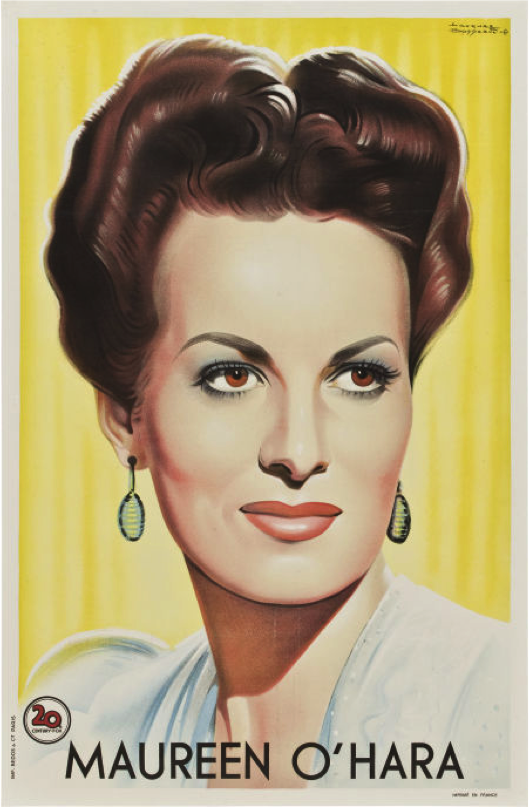
It seemed the right time to begin the poster show. The collection is based on design, finding the best poster for a film, regardless of country of origin. She reacted to each one.
From the '30s to the '50s, the major studios produced a series of portrait posters of their stable of stars. These were displayed in theater lobbies and often adapted as an advance poster, announcing the name of a future film under the actor's name. MGM, Warner Bros., Paramount and 20th Century Fox were the studios that produced the most impressive star portraits.
So I began the poster show with French artist Jacques Bonneau's pastel portrait from the 1940s, showing Maureen with her hair swept back. She stared at it , contemplating.
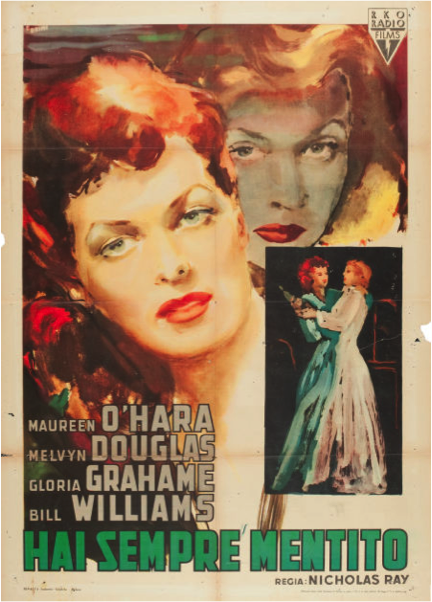
Next, the Italian poster of Nicholas Ray's A WOMAN"S SECRET (1949), a fascinating drama of duality captured by Ercole Brini in his signature watercolor style. There was a large image of O'Hara in the foreground, shadowed by a similarly sized Gloria Grahame.
Maureen said she didn't like working with Ray but was absorbed by the poster, which featured an insert of the classic fight between the two women.
The Italians also came through with the large two panel for THE FALLEN SPARROW (1943)**, an underrated film noir in which she's the villain. Olivetti's representational portrait of a stunning O'Hara dominates a threatened John Garfield. O'Hara didn't agree with Garfield's politics but thought him "a terrific actor whom I liked a lot."
Something had been gnawing away at her as she kept returning to the first poster, the studio portrait. Then it clicked, "That's the way I wore my hair in 'TEN GENTLEMEN FROM WEST POINT."
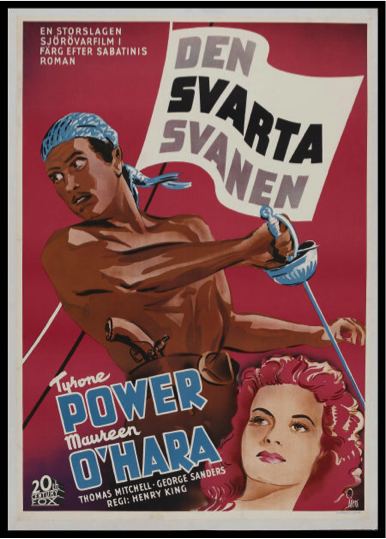
The Swedish poster for Henry King's THE BLACK SWAN was bathed in reds. Shirtless pirate Tyrone Power was the predominate figure, with O'Hara positioned in the right corner, her redder hair accenting the background. I proposed that Gosta Aberg, the Swedish artist, had purposefully used red to re-enforce O'Hara's presence and that it was the most prominent use of red in any of her posters.
Whether I was sounding too sure of myself or her humor was brewing, she countered, "You'd be surprised!"
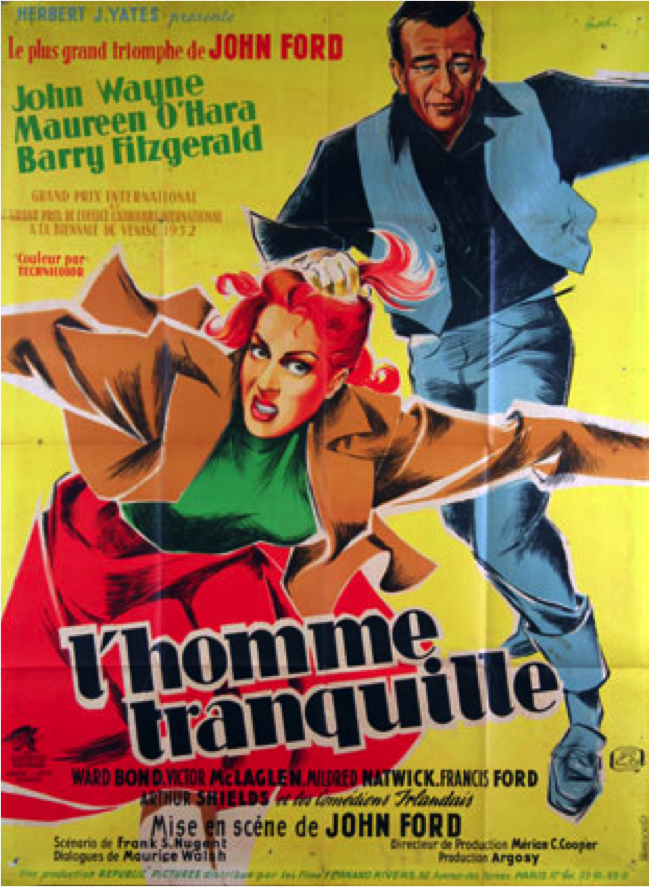
I saved THE QUIET MAN for last; it was a three-poster presentation.
Clement Hurel's French poster captured the dynamic between Wayne and O'Hara. She was running away from him, running out of the poster while he held her back by her hair. It had automatic impact. It spoke for itself. She studied it and smiled.

Next the small Belgian poster with the two stars facing each other in profile.
The bottom third was a portrait montage of Wayne and O'Hara and the three supporting actors - Ward Bond, Victor McLaglen and Barry Fitzgerald.
In describing the layout, I chose
my words poorly, noting
she was "included again"
in those images.
She called me on that,
"What do you mean 'again?'"
I had meant to say the designer
had selected a beautiful full face image for the montage portrait,
complementing her profile
in the poster's upper third. \
I was embarrassed but energized to
have experienced Maureen O'Hara's spunk.
Saving the Danish QUIET MAN for last, she viewed the green picturesque Irish landscape that evoked the film's magical quality. "Sean Thornton" and "Mary Kate Danaher" were poised by the brook in front of their cottage.
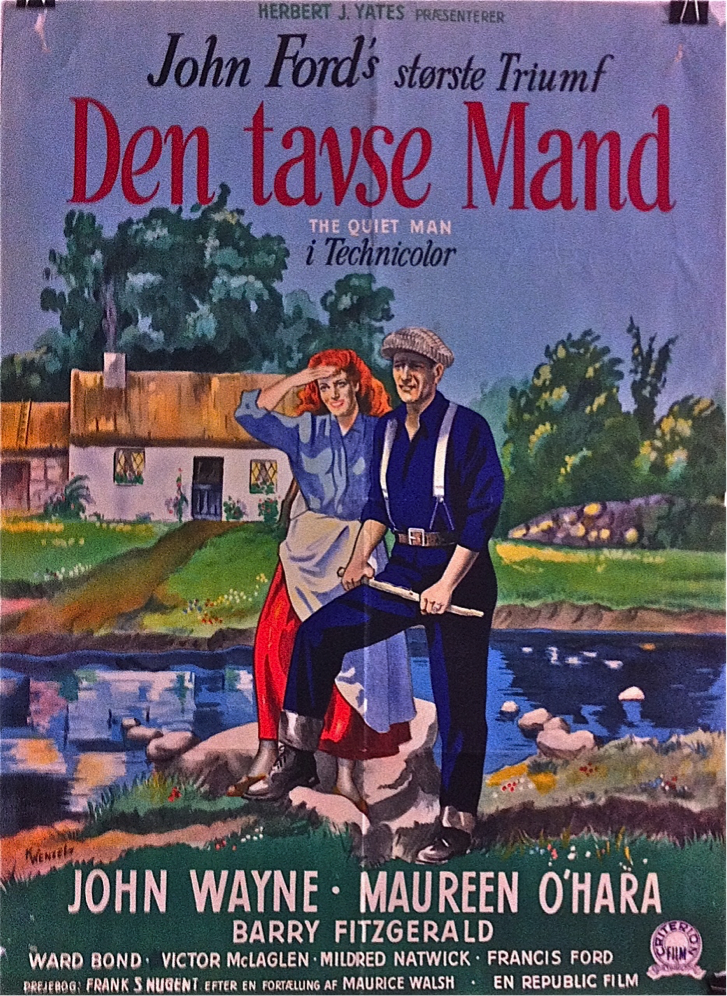
Miss O'Hara was pleased...with one caveat, "the cottage may be a bit too modern."
And then she added, "I could do this all day."
Before leaving, I asked if I could kiss her.
"Of course," she said.
She then asked me to flatten my hair, which had been mussed up during the poster show.
"You look much better that way."
* * *
Maureen O' Hara was John Ford's favorite actress, starring her in five films....RIO GRANDE, THE LONG GREY LINE, THE WINGS OF EAGLES, THE QUIET MAN, and the Oscar-winning HOW GREEN WAS MY VALLEY. Ford was notoriously mercurial, a great artist who could be kind, generous and inspiring as well as mean, difficult and sadistic.
In a later meeting, she elaborated, "Ford wanted to outdo everyone, wanted to be the best singer, hoofer, fighter, conniver, scoundrel...and he was. He had the divilment."
We had a Ford connection via Lindsay Anderson, the British critic, filmmaker and provocateur who called Ford "the poet of the cinema." He had written an esteemed critical analysis -- About John Ford--and later conducted a rare interview with O'Hara for his Ford documentary.
I produced Lindsay's last film, THE WHALES OF AUGUST, and directed Malcolm McDowell's tour-de-force about Lindsay, NEVER APOLOGOZE, the most moving section being the emotional account of Anderson's visit to a dying Ford. During that visit, Ford cited four colleagues - two who had come to see him --Howard Hawks and Henry Fonda ("a nice man") - John Wayne (testy that "the Duke was in San Francisco making some damn police picture")-- melancholy about Maureen O'Hara ("She's in the Caribbean)."
In his eulogy to Ford, Francois Truffaut wrote, "Because of him, a splendid actress like Maureen O'Hara was able to play some of the best female roles in American cinema between 1941 and 1957."
Besides THE HUNCHBACK OF NOTRE DAME, the artistic triumphs and her exotic swashbucklers, she had captivated from the first in Hitchcock's JAMIACIA INN, brought holiday radiance to MIRACLE ON 34th STREET and motherly balance to THE PARENT TRAP, both blockbusters; scored in successes less known today, the classic soap opera, SENTIMENTAL JOURNEY; the comedy sensation, SITTING PRETTY, in which she parried the eccentricity of Clifton Webb; experimented in THE DEADLY COMPANIONS, Sam Peckinpah's first film and OUR MAN IN HAVANA, Carol Reed's satiric comedy with Alec Guinness, and continued in mainstream family fare - MR. HOBBS TAKE A VACATION; SPENCER'S MOUNTAIN, where she elevated predictability.
Screenwriter and critic Jay Cocks: "She brought spirit and humor, unyielding strength and sensitivity even to roles that as written could be as flat as a slice of soda bread...She is a vital part of the greatest poetry of the cinema. There is no one like her or has ever been."
Yet if one hadn't been exposed to classic movies, one could have been unaware of Maureen O'Hara, impossible as it seems. She had retired from films in the 70's and hadn't appeared on the big screen for another twenty years until director Chris Columbus convinced her to accept the role he created for her in 1991's ONLY THE LONELY.
Turner Classic Movies and the TCM Festival rectified the omission, recognizing her importance in the spring of 2014, when Maureen O'Hara became their star attraction. A journalist who had covered every TCM Festival since its inception wrote that the longest festival line he had ever seen was the one waiting for Maureen O'Hara to introduce HOW GREEN WAS MY VALLEY.
VANITY FAIR's "Proust Questionaire" asked what was her most marked characteristic. Her answer, "The hell and fire in me - they came as a set".
In July , she was TCM's "STAR OF THE MONTH", with twenty six of her sixty films on view, interspersed with her interviews with Robert Osborne. New audiences were now able to bask in the O'Hara fire.
* * *
During the Governors Awards' career compilation, film clips and photographs flashed by amid tributes from Nicole Kidman and Steven Spielberg, who paid homage with his QUIET MAN sequence in ET. O'Hara's work could have been taken for granted, overlooked by her beauty, which made Melvyn Douglas forget his lines during A WOMAN"S SECRET. Like all the great ones, she made it look easy.
An amalgam of images merged -- fury, beauty, passion, romance, sparkle. If there is a common denominator, it's the bounty of her spirit. One swells with admiration.
That was joyful to witness at the Governors Awards.
The year's Oscar contenders were in abundance, attending to the red carpet, mingling with each other at the rear of the Dolby Ballroom during the reception period which spilled into the awards timetable. Academy President Cheryl Boone Issacs had difficulty wrangling the volatile room but her calming graciousness prevailed as the stars found their studio tables.
During the reception and before dinner, the four honorees and their guests were at long tables at the Ballroom center. (Maureen's guests included: actor-producer Patrick Wayne, representing his late father; actress and animal activist Stephanie Powers, a friend from McLINTOCK; director Chris Columbus and his wife; Elaine Parky, her long-time accompanist; June Beck, the founder and editor of the O'Hara website; friends Donal and Ilene Deasy from Ireland, The Nicolettis and Conor & Elga Fitzsimons and family). Liam Neeson and his party arrived as dinner was served.
There wasn't a seating chart so it was difficult to find people without roaming. Three figures, however, were compelled to make their way to Maureen.
Hayao Miyazaki, the brilliant, innovative Japanese animator, who was also being honored, walked directly towards her with his translator, beginning an intense encounter. The two honorees enjoyed each other, laughing and listening. As Miyazaki left, he placed his palms together and shook his hands three times.
His face glowed.
The glow continued through his acceptance speech, when he thanked the Academy for being honored, acknowledging his luck to be "able to participate in the last era when we can make films with pencil, paper and film. But my greatest luck," he concluded to enthusiastic applause, "is that I was able to meet Miss Maureen O'Hara tonight."
After Miyazaki, a young girl with long red hair knelt before her. It was difficult telling who she was but from her body language, she was in deep conversation.
As Jessica Chastain turned around, photographers materialized to capture the two redheads. Rising in almost the same place as Miyaski, she began tapping her hand to her heart, marking the experience.
Her smile reached from ear to ear; she was in a state of euphoria. She told Francesca Nicoletti that every time she made a film, her first thought was how would Maureen O'Hara play it.
Then a tall vision appeared in a gold sheath, platinum hair rising, looking like an elegant Statue of Liberty. Tilda Swinton had come to pay her respects.
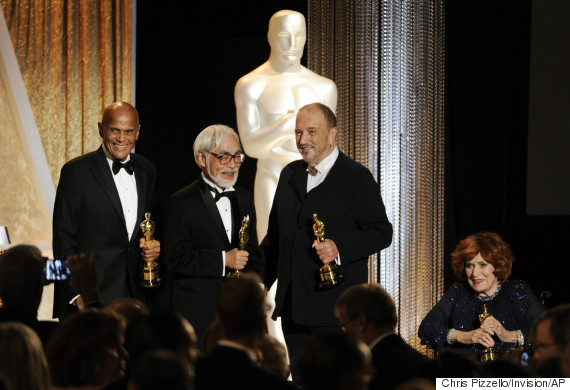
There was one more tender sighting after the four honorees stood together for final recognition: Harry Belafonte, Hayao Miyaski, Maureen O'Hara , and screenwriter Jean-Claude Carriere, who kissed her head.
* * *
Not knowing whom I might know that night, I had emailed Sid Ganis, the respected former president of the Academy, a colleague since our youthful days in New York, asking if he'd be attending.
Suddenly he was at the table, eyes gleaming, calling my name. I introduced him to Maureen and they sat together, holding hands, like old friends. I had briefed him about my O'Hara history, revealing that even after being with her on five different occasions, I still felt star struck.
Sid had written back, "I too remain star struck. It's a good thing."
* * *
THE NOMINATION - ARTHUR & JULIET
Arthur Hamilton, an Academy Governor from the Music Branch, nominated Maureen O'Hara for an Honorary Academy Award.
A former officer of the Board and highly esteemed for his years of service and dedication, his words would set the tone for her candidacy. The composer and lyricist of "Cry Me A River," "Sing A Rainbow," "He Needs Me" and many other songs, he was expert at conveying meaningful emotion through imaginative imagery.
The board would be aware of the numerous testimonial letters that had been written by distinguished Academy members and Oscar winners over the three years we had assembled support. This would be the third time Arthur would place her name in nomination.
He summed up his feelings with simplicity, recognized Maureen O'Hara's allure and reminded his fellow Governors that his wasn't a first-time endeavor:
"WHEN A MAN STANDS HOPEFULLY BENEATH THE
BALCONY OF A BEAUTIFUL WOMAN - BUT SHE
DOESN'T APPEAR - - - IF HE'S REALLY SERIOUS,
HE SHOWS UP THE NEXT NIGHT.
THIS IS MY NEXT NIGHT."
He received numerous congratulations for his words.
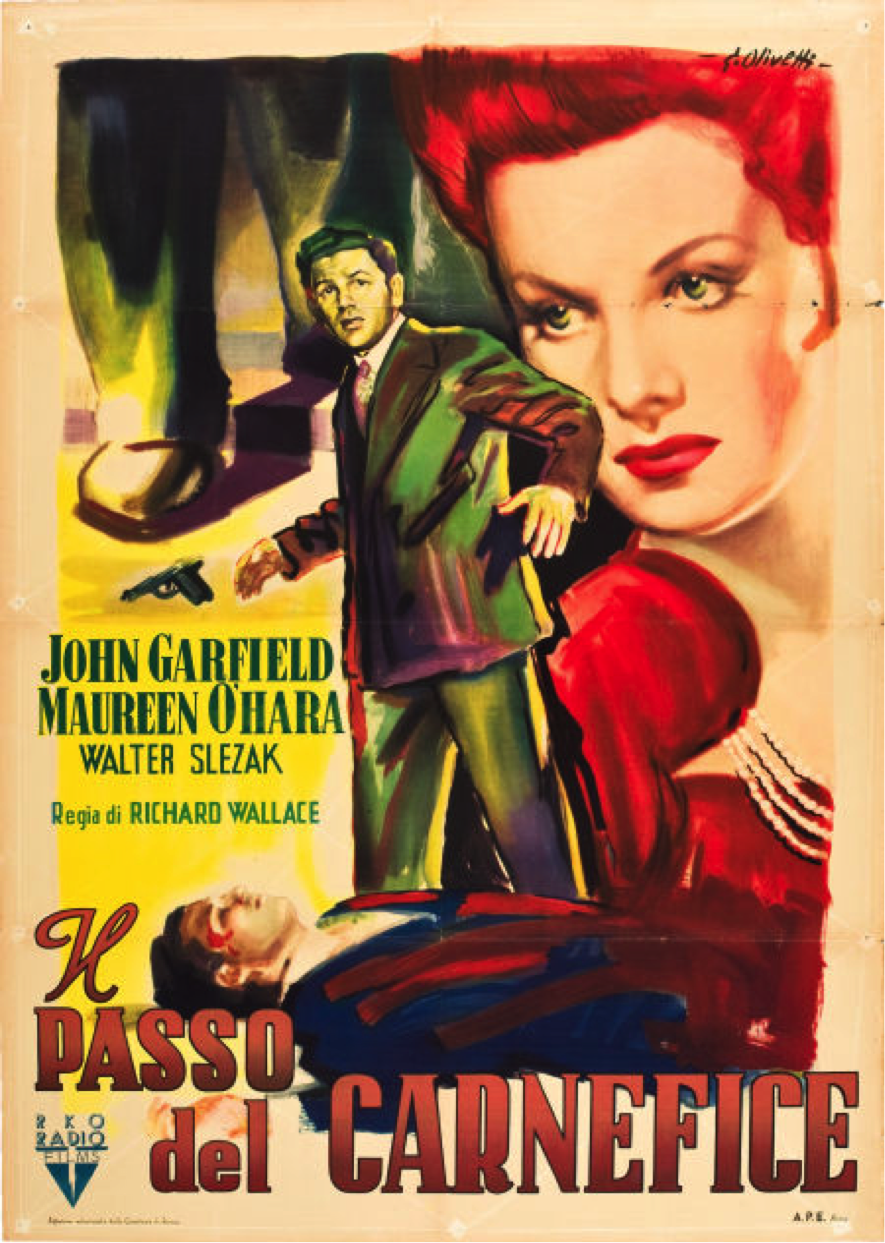
A version of this piece first appeared on Thompson on Hollywood/IndieWire.